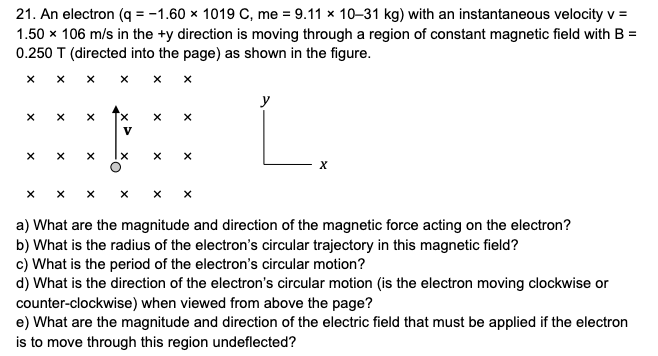21. An electron (q = -1.60 × 1019 C, me = 9.11 × 10–31 kg) with an instantaneous velocity v = 1.50 x 106 m/s in the +y direction is moving through a region of constant magnetic field with B = 0.250 T (directed into the page) as shown in the figure.
21. An electron (q = -1.60 × 1019 C, me = 9.11 × 10–31 kg) with an instantaneous velocity v = 1.50 x 106 m/s in the +y direction is moving through a region of constant magnetic field with B = 0.250 T (directed into the page) as shown in the figure.
Chapter13: Electromagnetic Induction
Section: Chapter Questions
Problem 43P: A 25-cm nod moves at 5.0 m/s in a plane perpendicular to a magnetic field of strength 0.25 T. The...
Related questions
Question
I am uncertain about parts d and e.

Transcribed Image Text:21. An electron (q = -1.60 × 1019 C, me = 9.11 x 10–31 kg) with an instantaneous velocity v =
1.50 x 106 m/s in the +y direction is moving through a region of constant magnetic field with B =
0.250 T (directed into the page) as shown in the figure.
L.
y
V
a) What are the magnitude and direction of the magnetic force acting on the electron?
b) What is the radius of the electron's circular trajectory in this magnetic field?
c) What is the period of the electron's circular motion?
d) What is the direction of the electron's circular motion (is the electron moving clockwise or
counter-clockwise) when viewed from above the page?
e) What are the magnitude and direction of the electric field that must be applied if the electron
is to move through this region undeflected?
Expert Solution
This question has been solved!
Explore an expertly crafted, step-by-step solution for a thorough understanding of key concepts.
This is a popular solution!
Trending now
This is a popular solution!
Step by step
Solved in 2 steps

Knowledge Booster
Learn more about
Need a deep-dive on the concept behind this application? Look no further. Learn more about this topic, physics and related others by exploring similar questions and additional content below.Recommended textbooks for you


College Physics
Physics
ISBN:
9781305952300
Author:
Raymond A. Serway, Chris Vuille
Publisher:
Cengage Learning

College Physics
Physics
ISBN:
9781285737027
Author:
Raymond A. Serway, Chris Vuille
Publisher:
Cengage Learning


College Physics
Physics
ISBN:
9781305952300
Author:
Raymond A. Serway, Chris Vuille
Publisher:
Cengage Learning

College Physics
Physics
ISBN:
9781285737027
Author:
Raymond A. Serway, Chris Vuille
Publisher:
Cengage Learning

Physics for Scientists and Engineers, Technology …
Physics
ISBN:
9781305116399
Author:
Raymond A. Serway, John W. Jewett
Publisher:
Cengage Learning

Principles of Physics: A Calculus-Based Text
Physics
ISBN:
9781133104261
Author:
Raymond A. Serway, John W. Jewett
Publisher:
Cengage Learning